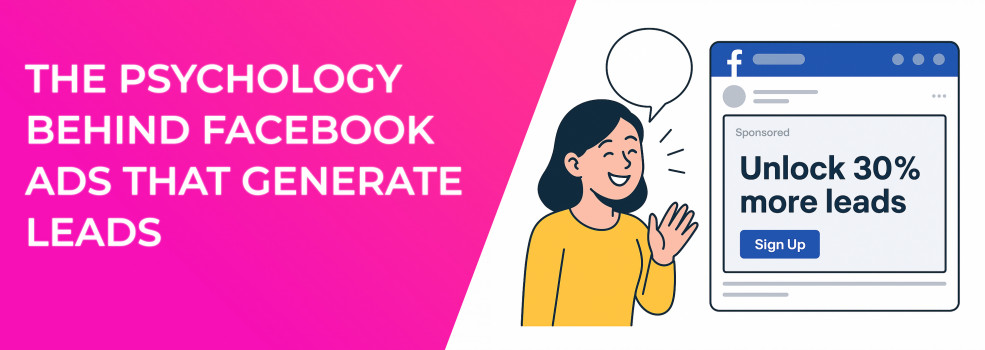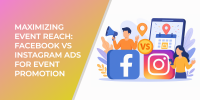Ever wonder why some Facebook ads freezes your thumb mid-scroll while others fade away? The difference is rarely luck. It is psychology: advertisers who respect how the brain filters information position their messages so they feel personal, urgent, and trustworthy. When these mental cues line up with proven lead generation best practices, conversions follow.
To see why certain messages grab attention instantly, read The Psychology of Facebook Ads: How to Hook Your Target Audience in Seconds.
1. The Power of Personalization
Generic ads are easy to ignore; personalized ads feel like helpful suggestions. The first step is to create Pixel on Facebook and feed it quality data. Pair that data with FB retargeting audiences, CRM uploads, or on-site behavior to deliver copy and creatives that match each user’s stage in the buying journey.
If you’re just starting out, Facebook Ad Targeting 101: How to Reach the Right Audience lays the groundwork for building precise segments.
Practical workflow
-
Someone downloads your pricing guide.
-
The Pixel tags that visit and drops the user into an evaluation segment.
-
An ad generator Facebook script builds a carousel of customer testimonials that highlight cost savings.
-
You enable advantage campaign budget rules so more spend flows to this high-intent cluster.
Not sure whether to scale with a mirror or a mirror-plus strategy? Custom vs Lookalike Audiences: What Works Best for Facebook Campaigns? breaks down the trade-offs.
Teams that embrace this level of granularity often see cost-per-lead drop by 20 to 40 percent and jump onto shortlists for “best lead generation services.”
2. Emotional Triggers Drive Action
People click because they feel something, not because they ran a spreadsheet. Emotion is rocket fuel for Facebook ad optimization. In practice that means:
-
Excitement: “Unlock 30 percent more leads in two weeks.”
-
Fear: “Stop losing budget on underperforming campaigns.”
-
Belonging: “Join 1,000 marketers swapping lead-generation tips in real time.”
Strong feelings like excitement, fear, and belonging drive clicks and conversions.
For word-for-word inspiration, bookmark Crafting Compelling Facebook Ads Copy That Converts.
Neuroscience studies find that ads with a clear emotional hook double recall compared with purely rational messages, explaining why campaigns that blend logic with feeling clock the highest conversion rate lifts.
3. Cognitive Biases in Ad Design
Cognitive shortcuts dictate how quickly users process information. Three of the most valuable for buyer lead generation are:
-
Social proof: Screenshot reviews, publish B2B lead generation examples, display real-time user counts.
-
Authority: Show industry certifications or mention analyst coverage.
-
Scarcity and urgency: “Only three demo slots left this week” outperforms “Book a demo any time.”
A SaaS firm layered all three principles into one creative and saw click-through rate jump 54 percent while qualified leads doubled in a month.
Match each bias to the perfect creative type with The Ultimate Guide to Facebook Ad Formats.
4. Simplify the Conversion Path
Every extra click invites drop-off, especially on mobile. Keep friction low and momentum high:
-
Replace paragraphs with bullets so busy users skim benefits in seconds.
-
Use a single call to action such as “Get My Free Audit.” Competing buttons split attention.
-
Deploy Facebook instant forms or lead gen form templates so fields auto-fill.
-
Compress images; page loads under two seconds can lift conversions by up to 20 percent.
These tweaks turn a curious scroller into a name in your CRM, ready for lead nurturing.
If conversions still stall, troubleshoot with Facebook Ads Not Converting: How To Fix It.
5. Data-Backed Ad Optimization
Great campaigns are never “set and forget.” Continuous testing and campaign budget optimization keep results trending upward. Speed through the learning cycle with How to Finish the Facebook Learning Phase Quickly.
Focus on:
-
Creative variables: Static image versus video, headline length, emoji use.
-
Offer depth: Lead magnet checklist download versus live workshop invitation.
-
Bid strategy: Rotate between cost cap and campaign budget optimization depending on scale goals.
-
Audience health: Refresh look-alikes every 30 days and cull segments with high frequency.
Continuous testing and budget optimization keep lead costs dropping over time.
If the platform flashes “Ad Set May Get Zero,” follow the fixes in Why You See “Ad Set May Get Zero” on Facebook and How to Fix It.
A retailer that logged each hypothesis and metric in a simple lead generation guide spreadsheet trimmed CPC by 28 percent and captured 42 percent more leads in one quarter.
6. Putting It All Together
High-performing lead generators succeed because they blend deep psychological insight with disciplined testing. They make users feel seen, spark genuine emotion, exploit predictable mental shortcuts, remove every ounce of unnecessary effort, and then iterate fast.
Start small: audit one campaign for emotional hooks, add a social-proof element, streamline your lead generation landing page, and schedule an A/B test. Then let the data tell you what to scale. By combining behavioral science with Facebook ads optimization tools, you turn attention into action and action into revenue.
For an even wider view of future tactics, see Mastering Lead Generation in 2025: Top Tactics for Success.

